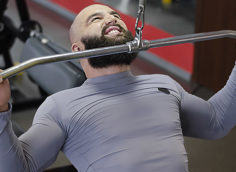The Spinal Flexion Debate
Spinal flexion: That's what it's called when you do any kind of sit-up or crunch. Some fitness pros argue that it's bad for the spine, while others say crunching forges a strong and functional core.
Who's right? Well, it's not a black or white issue. There's a smart way to train the crunch and sit-up while saving your back at the same time. Here are three methods to train spinal flexion properly.
With any movement, speed is a form of progression that can be used to make a movement more advanced. Ab exercises are no exception.
As spinal flexion exercises increase in speed, there's an increased risk of compensation. And this compensation may place unwanted stress through the lower back and posterior pelvic girdle. The faster you move, the more agile you must be to not only gain but also maintain stability through the entire kinetic chain. Instability, especially through the spinal column and pelvis is the perfect recipe for injury.
Since dysfunctional weaklings (no offense) make up the majority of the core centric-training crowd, crunching away like Hershel Walker, the likelihood of them being able to control an advanced variation of a foundational movement with increased velocity is slim. They're lurching themselves up in an uncontrolled manner without even knowing it, and receiving little to no aesthetic benefit either.
The most effective way to maximize full body tension is to slow down the speed of the movement and accentuate the tempo. This will increase stability throughout the shoulders, core, and hips.
People are familiar with slowing down the eccentric or lowering portion of a lift to maximize time under tension, but what about the concentric or lifting portions? Both can be manipulated to make spinal flexion safer and more effective.
Here's what to do: Move slowly into a controlled range of spinal flexion, then strategically lower under perfectly controlled multi-joint stability. You'll reduce lower back flare-ups and build a strong core. These translate into both the big lifts and life itself.
Accentuated Tempo Reverse Crunch
Start with a 2-3 second concentric (lifting) portion of a crunch-based movement, and lower with another 2-3 second descent. If you execute these reps with authority, it will take you anywhere from 5-8 seconds to do a perfect rep. Keep that in mind when you start throwing your torso onto and up from the ground, you're just pounding your spine into another injury.
The plank, an isometric pose, was a movement that functional training gurus flocked to as soon as there were signs pointing to spinal flexion as a culprit for shear and compressional forces through the lower lumbar spine. But it's time to think outside the traditional plank. There's more than one way to use isometric contractions to make ab gains.
You can use isometric properties to safely train spinal flexion. And you ought to if you want a stronger, better looking core. Isometrics activate the targeted muscle by increasing muscular recruitment in a static position in order not to deviate from that central setup. If you've mastered your controlled sit-up or crunch tempo, then start sprinkling isometric holds into your direct spinal flexion core training.
Here's what to do: Try isometric holds at any degree in the range of motion of the movement. It'll increase the recruitment of the rectus abdominis and, to some extent, hit the internal and external obliques and other deeper stabilizers of the spine and pelvis. Your focus here needs to be using iso-holds to enhance the sit-up variation, not deter from it in the form of loss of volitional positional tension and spinal and pelvis positioning.
Decline Sit-Up, Iso-Hold at Top and Bottom
Start with adding a 1-3 second isometric hold at the top of the sit-up, tapping into your mind-muscle connection and squeezing as hard as you can with 100% effort. This small use of isometrics during an otherwise dynamic exercise is a game changer and something that you'll "feel" instantaneously.
Try placing an isometric hold at the bottom portion of the range of motion. Here's why: Many times in the sit-up, people will lose their tension and core positioning at the bottom, resting but not bracing with their back on the bench or ground. Then they try to re-recruit tension and stability before every single rep.
It's hard enough to create proper pillar tension once. You don't want to be doing it repeatedly, especially when you're trying to time it with a dynamic contraction into flexion of the spine.
By using an isometric hold of 1-2 seconds at the bottom range of the movement, you'll get the bonus of continuous tension and core stability throughout all the reps in a set. You'll also increase your total time under tension of the set, which is great for strength, hypertrophy, and looking sexy.
Partial ranges of motion can improve activation and recruitment of the core muscles. And it can re-educate your core so that its strength can be transferred back into the compound lifts... and, you know, movement necessary for daily living.
Training spinal flexion with targeted emphasis on the diaphragm position and activation of the rectus abdominis is nothing new, as Dr. Stu McGill has been teaching his "McGill Curl Up" for decades with success. But as soon as an exercise is considered a "therapy" based exercise, the strength and aesthetics training world seems to throw it aside for being too low-level to create marked results.
While flexing the spine repeatedly can create compensation patterns of the pelvis falling into posterior pelvic tilt and potentially placing undue stress on the non-contractile structures of the spinal column, we often forget about the potential problems with over-extending the spine.
Many times, the position that we want to be focusing on limiting with partials is the bottom of the range of motion where tension would be lost anyway. Avoid falling into an unwanted extension at the lumbar spine by using a pad behind the head, neck, and shoulder blades.
Here's what to do: Use a pad to elevate into a more passively flexed position at the thoracic spine and rib cage. This position will improve the strength curve of the rectus abdominis, allowing a more targeted way to overload these tissues with load or metabolic stress without jeopardizing the spinal position.
Plate Push, Partial Range
If you struggle to engage the posterior chain to stabilize the pelvis, a great variation for the partial range of motion crunch is placing your legs on a weight bench in a 90-90 position. From this position, add a pad to the back to create the perfect position to gain muscle tension and recruitment, and to safely train the spine using a controllable and strategic flexion. It's best to get the hips flexed to over 45 degrees which helps the pelvis to stabilize more effectively.





